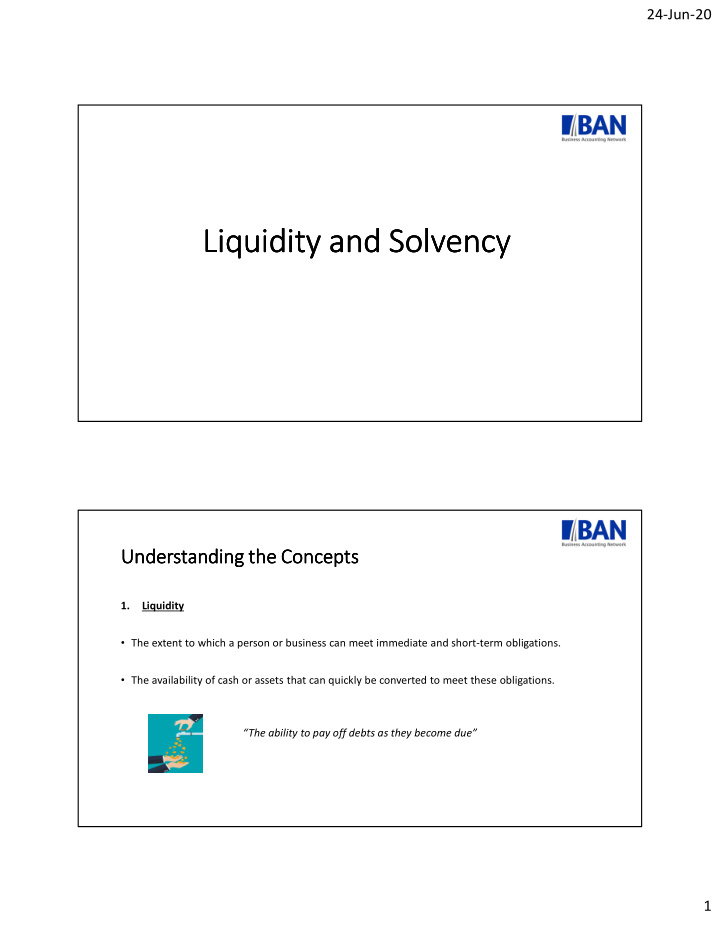



24-Jun-20 Liquidity and Solvency Liquidity and Solvency Liquidity and Solvency Liquidity and Solvency Understanding the Concepts Understanding the Concepts Understanding the Concepts Understanding the Concepts 1. Liquidity • The extent to which a person or business can meet immediate and short-term obligations. • The availability of cash or assets that can quickly be converted to meet these obligations. “The ability to pay off debts as they become due” 1
24-Jun-20 Understanding the Concepts Understanding the Concepts Understanding the Concepts Understanding the Concepts Understanding the Concepts Understanding the Concepts Understanding the Concepts Understanding the Concepts 2. Solvency • The extent to which a person or business can meet its long-term debts and financial obligations. • The value of business assets must be greater than the sum of its liabilities. “The ability to continue operations into the foreseeable future” 2
24-Jun-20 Understanding the Concepts Understanding the Concepts Understanding the Concepts Understanding the Concepts Understanding the Concepts Understanding the Concepts Understanding the Concepts Understanding the Concepts 3
24-Jun-20 Practical considerations Practical considerations Practical considerations Practical considerations Measuring liquidity • Current ratio ( working capital ratio ) = current assets / current liabilities • Quick ratio ( acid-test ratio ) = (current assets – inventory) / current liabilities • Operating cash flow ratio = operating cash flow / current liabilities Practical considerations Practical considerations Practical considerations Practical considerations Measuring solvency 1. Debt to equity = total liabilities / total equity 2. Debt ratio = total liabilities / total assets 3. Interest coverage ratio = EBIT / Interest expense 4. Solvency ratio = (Net income after tax + non-cash expenses) / total liabilities 4
24-Jun-20 Practical considerations Practical considerations Practical considerations Practical considerations Keeping an eye on the financial health of your business • Management accounts and monthly reporting (accurate vs timely) • Financial knowledge and assistance of your accountant • Interpretation of ratios is key • Look out for month to month trends and sudden changes • Also consider how ratios will be affected in future – forecasts and budgeting • Identify problem areas early on and develop strategy to remedy these Practical considerations Practical considerations Practical considerations Practical considerations 5
24-Jun-20 Business impact Business impact Business impact Business impact Improving liquidity: • Increase the working capital cycle • Switch from short term to long term debt • Dispose of unproductive or underperforming assets • Control overheads and costs Business impact Business impact Business impact Business impact Improving solvency: • Trade out of insolvency – quality and good service are key • Marketing plan to increase revenue and profitability • Owner assistance in the form of equity investments • Try to avoid new debt • Re-organise and manage costs 6
24-Jun-20 Covid Covid Covid Covid- - - -19 19 19 19 • Many businesses are facing financial distress • Additional finance required BUT can you repay and service these additional obligations? • Business plan now required by all banks – financial plan also includes marketing plan • Liquidity and solvency more relevant than ever before “Financial management and monitoring are key to surviving the tough times” Join us for the next of our Client Webinar series Webinar Made Simple for the SME Business Sector 29 July 2020 09:00 – 10:00 7
24-Jun-20 Questions? Questions? Questions? Questions? 8
Recommend
More recommend